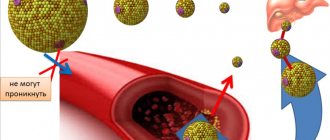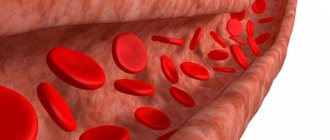The essence of pathology
Labile hypertension is characterized by a constant change in blood pressure. The readings may be normal, then sharply increase to high levels of 140 per 100 mm Hg. Art., then return to normal again without the use of antihypertensive drugs.
After some time, the situation may repeat itself: the pressure rises again and returns to normal on its own; there may be no additional symptoms.
Labile hypertension is characterized by instability and fluctuations in blood pressure
The disease cannot be left unattended; regular surges in blood pressure require therapeutic assistance. Jumps in blood pressure affect the cardiovascular system, the walls of the arteries become thinner, which can lead to serious abnormalities in the functioning of the heart.
At the first signs of the disease, you should consult a doctor who will help make a diagnosis and identify the cause of pressure surges. This is a prerequisite for drawing up a treatment regimen.
Symptoms of the disease
In addition to occasional increases in blood pressure, patients complain of the following ailments:
- the appearance of “flies” before the eyes;
- sleep disturbance and difficulty falling asleep;
- headache, which most often occurs in the occipital region;
- increased irritability, emotional instability;
- an occasional feeling of numbness in the limbs;
- decreased attentiveness and memory impairment.
If there is no treatment for labile blood pressure, these symptoms will gradually progress, significantly reducing the patient’s quality of life.
Causes of lability and correct definition of this condition
Many people are interested in whether labile blood pressure is a symptom or a disease? Since lability is a manifestation of a certain pathology, we can say that this state of blood pressure is a symptom. As mentioned above, sudden changes in blood pressure can cause hypertension, so this condition can be regarded as a symptom of hypertension.
Other diseases in which variable blood pressure is a symptom:
1. Vegetative-vascular dystonia
Since VSD often causes serious disturbances in vascular regulation, they may manifest as lability.
2. Diabetes mellitus
This disease affects the blood vessels, making the vascular system too sensitive to any influence, and blood pressure becomes variable.
3. Obesity
Everyone knows that excess weight is an independent disease that entails multiple complications. These primarily include atherosclerosis and a tendency to hypertension, which causes unstable blood pressure.
These diseases most often cause labile blood pressure. However, there are some reasons that can also cause the development of this pathology:
- elderly age;
- hereditary predisposition;
- alcohol abuse;
- smoking;
- sedentary lifestyle;
- increased salt intake;
- high caffeine consumption;
- stress and frequent anxiety.
The first two reasons are universal and cannot be prevented. Fortunately, all other causes of the disease can be influenced from the outside by preventing variable blood pressure.
Lability of blood pressure leads to the fact that the patient occasionally experiences spasm in the arteries, which greatly worsens the patient’s condition. Important: this condition leads to a narrowing of the blood vessels, so strong pressure of the blood flow begins on their thin walls. Over time, blood pressure returns to normal and then changes again for some reason. We can say that lability is one of the forms of hypertension, for which treatment is not necessary. But if the patient’s condition worsens, he will develop hypertension, for which appropriate treatment is prescribed. It will be in the interests of the patient himself to control blood pressure, which will improve the quality of life and allow him to maintain good health for a long time.
Reasons for the development of the disease
The pathogenesis of the development of labile arterial hypertension has not been studied. Experts agree that the causes of surges in blood pressure are associated with poor lifestyle and external provoking factors. The main causes of labile arterial hypertension syndrome include:
- exposure to stress;
- excessive consumption of salty foods, coffee, strong tea;
- excess weight;
- alcohol and smoking;
- low physical activity;
- high cholesterol;
- hormonal changes during pregnancy, adolescence, menopause.
The risk group includes people with a hereditary predisposition. If there are relatives in the family with labile arterial hypertension, it is necessary to follow preventive measures and visit a doctor.
Excess weight is a risk factor for the development of pathology
What is labile arterial hypertension?
With this disease, unstable blood pressure is always present. In simple terms, this is a type of hypertension in which blood pressure suddenly rapidly “increases” to levels of 140 over 100, and after some time normalizes without the use of any medications. Further, the situation may repeat again and again, while symptoms may not appear.
Despite the fact that the pressure stabilizes on its own, the disease cannot be started, since with each increase in indicators the condition of the vascular walls worsens. Therefore, deviation requires special attention and assistance from a specialist.
Despite the temporary nature of high blood pressure, it should not be ignored.
Symptoms
Very often the disease proceeds without any side effects, but some patients may experience characteristic signs of hypertension. Such as:
- Sleep disturbances and excessive anxiety;
- Regular mood swings;
- Headaches in the occipital region;
- Redness of the facial skin;
- Difficulty breathing (including shortness of breath).
Often, with labile hypertension, the patient’s limbs go numb due to circulatory failure. Many also complain of loss of performance and absent-mindedness. Without proper treatment, symptoms will increase and your health will worsen. The longer a visit to the doctor is delayed, the more serious the consequences.
If symptoms appear, you should consult a doctor so as not to worsen the situation.
Causes
All the reasons that could influence the occurrence of the disease have not been studied to this day. But experts say that in the vast majority of cases, pathology is a consequence of:
- Frequent severe stressful situations;
- Consumption of salt and coffee (in large quantities);
- Overweight;
- Abuse of alcoholic beverages and smoking;
- Lack of sufficient physical activity;
- High cholesterol levels.
Also, pressure lability can appear as a consequence of hormonal changes in the body, for example, during pregnancy, adolescence, or during menopause in women.
Note. The highest risk group includes people with a genetic predisposition. Therefore, if there are people in the family with labile hypertension, for prevention purposes you should regularly visit your doctor.
Symptoms of labile hypertension
Labile hypertension is often asymptomatic. The only indicator is an increase in blood pressure and normalization without additional intervention after a short period of time.
In some patients, the labile course of hypertension may be accompanied by additional symptoms:
- sleep disorders;
- increased feeling of anxiety;
- emotional lability;
- pain in the back of the head;
- facial hyperemia;
- respiratory failure;
- numbness of the limbs due to interruptions in blood circulation;
- decreased performance;
- impaired concentration.
If you do not consult a doctor in time, the symptoms will intensify and the patient’s general condition will worsen. At the first signs of labile hypertension, you should consult a doctor.
Characteristic symptoms
Labile blood pressure may not manifest itself in any way for a long time. The development of pathology can be suspected by the presence of:
- Periodically occurring painful sensations in the back of the head.
- Increased irritability for no apparent reason.
- Sleep disorders that manifest as persistent insomnia.
Frequent headaches are considered the main sign of the development of hypertension.
If your health worsens and such symptoms occur, it is necessary to monitor your blood pressure. To do this, you need to measure your blood pressure in the morning and evening for a week. Blood pressure can be measured in a clinic or purchased a tonometer and done at home. Mechanical and digital blood pressure monitors are quite easy to use and do not require any special skills.
Phases of the pathological process
There are two phases of labile arterial hypertension:
- phase A: the initial form of the disease, in which normal blood pressure is maintained most of the time, indicators increase only during stressful situations, excessive physical activity or the influence of other provoking factors;
- phase B: a transient phase in which the pressure fluctuates regularly, but then returns to normal without the use of antihypertensive drugs.
At the initial stage, blood pressure increases only under stress
What does labile pressure mean and characteristic signs?
Patients with labile blood pressure are practically healthy, but they need to constantly monitor their condition, since frequent changes in the condition of the blood vessels can cause the development of hypertension. In order to understand what labile blood pressure is, it is worth learning that the term “lability” means “unstable” or “sliding.” From this it becomes clear that labile arterial hypertension is variable or unstable pressure.
With this pathology, the clinical symptoms of the disease are minimal, and elevated blood pressure levels quickly return to normal. The danger of a labile state lies in sudden surges in pressure, and if no treatment is carried out, it can develop into hypertension. The pathology of labile pressure is characterized by the following characteristic indicators:
- a sharp increase in blood pressure;
- spontaneous and sharp decrease in blood pressure.
It is worth knowing that blood pressure is very different from arterial hypertension, and these differences are as follows:
- with hypertension, blood pressure is constantly elevated, whereas with labile blood pressure they increase only occasionally;
- Taking antihypertensive drugs helps reduce blood pressure in hypertension, and labile pressure indicators decrease on their own;
- Unlike hypertension, labile blood pressure is characterized by sharp changes.
Since labile arterial hypertension can cause the onset of hypertension, it is necessary to monitor this process in order to identify pathology at an early stage of development and, if necessary, prescribe treatment. These measures will help prevent the development of a more serious disease.
Stages of development of hypertension
Labile arterial hypertension is divided into three stages:
- initial (stage 1 hypertension): there are no symptoms, the disease slowly progresses over many years; the absence of symptoms does not indicate the safety of the disease, since the blood vessels and heart begin to suffer, the risk of developing acute cerebrovascular accident and dysfunction of the cardiovascular system increases;
- medium (stage 2 hypertension): the first signs of the disease begin to appear, but they do not affect the general condition of the patient; pressure readings correspond to moderate hypertension; pathologies begin to develop in the vessels and myocardium;
- severe (stage 3 hypertension): blood pressure regularly increases, the increase in levels is accompanied by severe symptoms, in parallel atherosclerotic disorders in the vessels and changes in blood flow may develop; at this stage there is a high probability of developing a hypertensive crisis.
Experts separately distinguish systolic labile hypertension - this is a condition in which only the upper value on the tonometer increases, and diastolic pressure remains normal.
What are the phases of lability?
Increases and decreases in blood pressure are often associated with disturbances in the functioning of the endocrine system, which causes deterioration of the condition of veins, blood vessels and arteries. Therefore, labile hypertension is divided into 2 stages:
- Phase A - onset of the disease Blood pressure indicators are most often in a normal state, however, as a result of overstrain or emotional failure, they can increase.
- Phase B – transient This stage leads to an increase in blood pressure as a result of increased blood pressure on the arterial walls. Patients often notice fluctuations in tone, which quickly normalize and return to normal.
There is also another classification of lability, in which 3 stages of pathology are distinguished:
- At the first stage, the picture of the pathology is blurred, so patients practically do not complain of malaise. Sometimes unpleasant changes occur that are associated with an uncontrolled change in mental state. In this case, the patient’s brain, kidneys, liver and blood vessels located in the eyes suffer from sudden jumps in blood pressure. The duration of this stage can reach more than 20 years. It is worth knowing that this condition increases the likelihood of developing cardiovascular diseases by 6 times, and a stroke by 5. A heart attack that occurs at the first stage often ends in the death of the patient.
- At the second stage of lability, the signs and symptoms of the disease may also be blurred, however, when diagnosing the patient, an elevated blood pressure level close to that of hypertension may be detected. The onset of damage to internal organs will also be observed, which is explained by a decrease and deterioration in the tone of the muscles of the walls of blood vessels located in the heart. At this stage, the patient may experience hypertensive crises, and then a urine test will show an increased content of red blood cells. A situation in which the patient is diagnosed with kidney dysfunction cannot be ruled out.
- At the third stage, pronounced symptoms are noted, characterized by sharp increases in blood pressure. The patient may also develop atherosclerosis of blood vessels, which impairs blood circulation and greatly complicates the picture of the disease. In addition, at the third stage of lability, suitable conditions are formed for the occurrence of myocardial infarction, hypoxia and coronary heart disease.
Danger of the condition and possible complications
In the initial stages of labile hypertension, the patient does not feel a deterioration in his condition or other symptoms for a long time, and therefore does not suspect the development of pathology. He does not consult a doctor in isolated cases of increased blood pressure, and therefore does not receive adequate treatment. Lack of treatment for labile hypertension leads to progression of the disease and the development of pathologies in the cardiovascular system.
Possible complications of labile hypertension:
- acute cerebrovascular accident;
- heart attack;
- hypertensive crisis;
- disorders in the brain.
If your blood pressure is unstable, you should consult a doctor to make an accurate diagnosis and identify the cause of the deviation. Timely treatment will help to completely get rid of the disease and avoid serious complications.
If labile blood pressure is not treated, a hypertensive crisis may occur.
Emergency help at home
If there is a sudden change in pressure, proceed according to the following scenario:
- Try to calm down, sit down or lie down.
- Call an ambulance.
- For high blood pressure, you can take medications such as Captopril or Nifedepine.
- Measure your blood pressure every 20-30 minutes.
- Take anti-anxiety medications if you feel very anxious or afraid. Corvalol and Valocordin help well.
- Wait for the doctor to arrive.
Taking medications to lower blood pressure should be carried out strictly as prescribed by the doctor.
In the chronic course of the disease, you can use folk remedies for high blood pressure at home:
- A foot bath with mustard helps a lot;
- a popular method among people is to wet a cloth with vinegar and apply it to your feet for 5-10 minutes;
- drink herbal tea. Chamomile, hibiscus, hawthorn, and mint will help well. This will help you calm down and feel relief;
- methods using garlic. One of them is to chop 2-3 cloves of garlic, mix with milk and drink.
Therapy for hypertension
Treatment of labile arterial hypertension is based on changes in habits and lifestyle. Basic recommendations:
- include fresh fruits and vegetables in your diet;
- follow a diet, reduce consumption of salty foods, coffee, strong tea, sweets;
- regularly consume fermented milk products and lean meat;
- regulate weight if you are overweight, eat small portions 4-5 times a day.
If blood pressure increases due to stress, you need to take mild sedatives: Glycine or motherwort tincture.
If you have a sedentary lifestyle, you should include daily exercise and walks in the fresh air.
If these recommendations do not help normalize blood pressure, the doctor prescribes antihypertensive drugs. Medicines can only be taken as prescribed by a doctor.
Daily walks help normalize blood pressure
Treatment
Labile hypertension is usually not treated with medications and other drugs, since the increase in pressure is small and is not accompanied by serious disturbances in the functioning of the heart and blood vessels. However, at this stage it is extremely important to change your lifestyle so that the disease does not progress and eventually develop into full-fledged hypertension.
First of all, you need to switch to a healthy diet. It is necessary to reduce the amount of fatty and fried foods in the diet, limit salt intake. It is advised to drink less coffee and strong tea, and more plain water. as well as juices and fruit drinks. Various herbal teas are also beneficial.
It is necessary to normalize the daily routine and increase the level of physical activity. You should sleep at least eight hours a day, in the morning you need to do light exercises, it is advisable to choose some kind of sport. It is necessary to spend more time in the fresh air, it is advisable to walk often. You also need to stop smoking and drinking alcohol.
If headache attacks begin to bother you with high blood pressure, you can take various sedatives based on medicinal herbs, for example, motherwort, valerian. If, despite the measures taken, the labile form develops into hypertension and the condition worsens, you should consult a doctor.
Prevention measures
To prevent the development of labile arterial hypertension, it is necessary to take preventive measures:
- rejection of bad habits;
- full eight-hour sleep;
- avoidance of stressful situations;
- regular gymnastics;
- proper nutrition;
- maintaining optimal body weight.
If you don’t have time to exercise, you can regularly take walks, run, go to the pool or take a contrast shower. Relaxing baths with aromatic oils will help reduce the impact of stress.
Causes of labile pressure
Hypertension affects people of all ages; it can often be detected in young people.
This pathology is diagnosed when the pressure reading is higher than 140/90 mm.
According to statistics, a third of all patients diagnosed with hypertension suffer from its labile form. In other words, these are those people who do not have constant pressure; its indicators are constantly changing.
However, it must be said that in almost all such patients, the condition returns to normal over time, but in twenty percent this condition develops into a chronic one. Treatment of this pathology should already be carried out with special-purpose drugs.
Unfortunately, scientists have not yet established the exact cause of labile hypertension. The reasons for this appearance are different, but the main ones can be called:
- An increase in impulses that come from the central nervous system. This occurs when a person is in severe emotional distress. This reason is often observed when the central nervous system develops during adolescence.
- Excess weight and lack of mobility. In this case, cholesterol plaques appear in the lumen of the blood vessel, blocking the path of blood flow.
- Diabetes. Due to the large amount of glucose in the blood, metabolism is disrupted. This condition needs to be treated urgently.
- Smoking and drinking alcohol. All this narrows the blood vessels; at first, such manifestations may occur infrequently, but over time, they develop into a chronic form.
- Coffee in large quantities, as well as salt in food.
- Heredity. If one of your close relatives had a labile condition in which blood pressure is high, then there is a high risk that the person will inherit it.
This condition is very dangerous because the walls can rupture and hemorrhage may occur.
Labile hypertension is not initially a priori one of the forms of hypertension, but after some time it is possible to transform one pathology into another. Doctors do not know about the exact etiological factors contributing to the development of unstable pressure syndrome, which greatly complicates the treatment of this disorder.
- stress;
- bad habits;
- hormone imbalance;
- obesity;
- physical inactivity;
- pregnancy;
- age characteristics.
During times of stress, a surge in pressure always occurs - this is a completely natural protective reaction that develops in response to the release of catecholamines (counterinsular hormones) into the blood. If a person does not know how to deal with this condition on a psychological level, over time, stress accumulates and becomes chronic.
It is logical to assume that this significantly depletes the nervous system, which has a very negative effect on the quality of sleep and the health of the entire body as a whole. The final result of such a failure is unstable SBP and DBP indicators with a tendency to periodic jumps.
Systematic consumption of alcohol has a negative effect on vascular tone - first, massive vasodilation occurs, and then their spasm (constriction) develops and blood pressure increases due to an increase in the peripheral vascular resistance.
Pregnant women, as well as women at the beginning of menopause and adolescents often have to deal with lability of blood pressure. In addition, there is another common reason for the development of the disorder - poor diet and excess salt in the body.
Patients with diabetes mellitus may experience lability in blood pressure numbers. This happens because elevated glucose levels can cause vasospasm (vasoconstriction) and increase vascular tone, which causes a jump in blood pressure followed by a fall as glucose decreases and the vasodilation associated with this.
Labile hypertension in children and adolescents
Labile hypertension affects children and adolescents aged 5-20 years. Labile hypertension in adolescents develops against the background of:
- obesity;
- cardiovascular disorders;
- hormonal imbalances.
With high blood pressure, teenagers may experience a general deterioration in well-being, pain in the heart, nervousness, and insomnia.
At the first signs of labile hypertension, it is necessary to show the child to a doctor.
The first signs of hypertension can be noticed in a teenager
Symptoms
Unstable pressure can be accompanied by characteristic manifestations of both hypertension and hypotension. The situation is aggravated by the fact that pressure changes can be sharp, and the symptoms will have a stronger impact on the person’s well-being.
The main symptoms of unstable blood pressure include:
- severe headache. It is especially felt in the occipital region;
- redness or paleness of the face;
- constant feeling of anxiety;
- irritability for no reason;
- emotional instability;
- deterioration of attention and fatigue;
- insomnia.
Periodic pain localized in the back of the head or crown
What is blood pressure lability?
Blood pressure is a health indicator that does not usually cause anxiety and fear in young people, but older people react to this phrase no longer so indifferently. When you are young and there is no reason to worry about your health, you are unlikely to enjoy good blood pressure, exemplary tests, and other markers of your somatic condition. But all this usually has to be assessed at the moment when somatics fails.
And if you consider that every fifth adult inhabitant of the Earth suffers from hypertension, you understand how important blood pressure is.
- Pressure, hypertension, increase
- Why does this unstable pressure occur?
- What is the danger of vasospasm during blood pressure lability?
- Two classifications of lability phases
- How does labile blood pressure manifest?
- How to determine
- How to treat the disease
- General tips for preventing the transition of labile blood pressure to hypertension
Let's start with the main thing - pressure is an indicator of the pressure of blood on the vascular walls. This is the most important, basic, defining value. Not only the state of the cardiovascular system depends on it: the work of many other organs and systems is associated with such an indicator as blood pressure. Finally, deviations in pressure from the norm are difficult not to notice - your health worsens, and each time it becomes more and more noticeable.
Causes of lability of blood pressure and pulse
In most cases, the factors influencing the development of lability are external and depend on the person’s lifestyle, nutrition, and habits. This differs from essential hypertension, the causes of which are often associated with pre-existing pathologies of the cardiovascular system and other organs. The following causes of blood pressure lability are identified:
- Strong psycho-emotional load on the body, stress, worries, lack of sleep. The central nervous system sends an excessive number of impulses to the vessels, the number of heart contractions increases, and pressure rises.
- Lack of physical activity. Exercising is necessary to strengthen the cardiovascular system and the body as a whole, and lack of activity increases the likelihood of developing high blood pressure.
- Poor nutrition. It has been proven that an excess of salty, fatty, and oversaturated with “fast carbohydrates” foods affects the development of hypertension, which often begins with blood pressure lability.
- Various endocrine diseases. The most common pathology leading to hypertension is diabetes mellitus. Also, problems with blood pressure can occur against the background of kidney disease.
- Bad habits, smoking, alcohol abuse. All this affects blood pressure levels, over time, short-term fluctuations in which can become permanent and develop into hypertension.
These are the main reasons why lability in blood pressure and heart rate may occur. In addition, there is a hereditary factor: reduced elasticity of blood vessels, their high fragility. This cause of hypertension is not so common; such people need to be especially careful about fluctuations in blood pressure.
Blood pressure lability can occur in women with the onset of menopause. This occurs due to hormonal changes in the body. Older women are especially advised to follow a diet and a proper daily routine.
Also, increased levels are a physiological norm during pregnancy, since during pregnancy the organs in the abdominal cavity are displaced and the pressure on the diaphragm and other organs increases. To exclude pathology, observation is necessary for several months after the birth of the child.
Important! Blood pressure instability can be avoided through prevention.
Blood pressure lability can occur in women with the onset of menopause. This occurs due to hormonal changes in the body. Older women are especially advised to follow a diet and a proper daily routine.
Treatment
Therapeutic measures are usually based on lifestyle adjustments. First of all, the patient should pay attention to the food consumed. Doctors recommend:
- Eat more berries, fruits, fresh vegetables;
- Reduce consumption of salt, coffee, confectionery;
- Add fermented milk products and meat (lean) to your diet;
- Avoid drinking coffee and strong tea;
- If you are overweight, reduce portions and divide meals into 4-5 times.
If the increase occurs due to stress, you can resort to the help of sedatives, for example, motherwort tincture or Glycine. In case of blood pressure surges due to a sedentary lifestyle, it is necessary to increase physical activity and play sports.
- To refuse from bad habits;
- Rest more;
- Avoid stress;
- Exercise;
- Eat healthy foods;
- Control body weight;
- Make time for proper sleep.
Treatment methods
Treatment of blood pressure lability comes down mainly to lifestyle changes and general strengthening of the body, especially in the early stages. Regardless of the stage of the disease, all patients are recommended to:
- eat right - less animal fats and more vitamins, fiber;
- walk in the fresh air and play sports;
- cope with the consequences of nervous stress by any means - music, meditation, soothing teas;
- maintain a balance of work and rest, do not overwork;
- If possible, give up bad habits.
Research shows that unstable blood pressure at a young age significantly increases the likelihood of hypertension in the future. This condition is more common in women; men are less susceptible to it.
An effective method for lowering blood pressure is hand baths with hot water. It is enough to hold your hands in it for 10 minutes, and the condition will improve. Another proven remedy is apple cider vinegar, which is applied to the feet as a compress for 15-20 minutes.
Treatment of unstable pressure
Treatment of blood pressure lability comes down to changing the patient’s lifestyle. The patient must follow several rules:
- increase your time in the fresh air (walks in the park are great);
- follow a diet. Do not eat a lot of fatty foods;
- quit smoking;
- do not abuse alcohol;
- play sports (tennis, yoga, morning jogging would be a good choice);
- try not to overwork, find time to rest;
- sleep at least 8 hours a day;
- learn to deal with the consequences of nervous breakdowns and stress.
Engage in recommended physical exercises.
Treatment of hypertension according to Neumyvakin deserves special attention. This method is also applicable in the case of labile pressure. It is based on the use of hydrogen peroxide as a therapeutic agent to lower blood pressure.
Basic rules of treatment:
- For the first time, take 1 drop of hydrogen peroxide per day. The next day – 2. Increase the dose to 10 drops.
- After this, take a week off.
- Further treatment should be continued in this way - take the medicine for 3 days (10 drops) and take a break for 3 days.
- During treatment with this method, the pressure will gradually return to normal. It is necessary to stop when the indicators reach normal levels.
The use of the Neumyvakin method is recommended in conjunction with drug treatment for unstable blood pressure. When choosing any method of therapy, be sure to consult your doctor.
- For the first time, take 1 drop of hydrogen peroxide per day. The next day – 2. Increase the dose to 10 drops.
- After this, take a week off.
- Further treatment should be continued in this way - take the medicine for 3 days (10 drops) and take a break for 3 days.
- During treatment with this method, the pressure will gradually return to normal. It is necessary to stop when the indicators reach normal levels.











